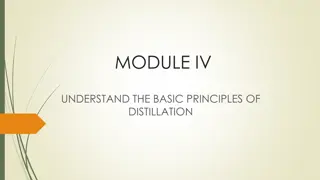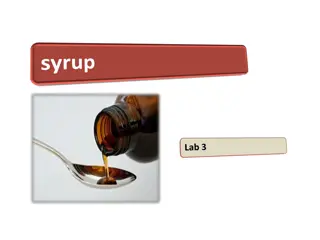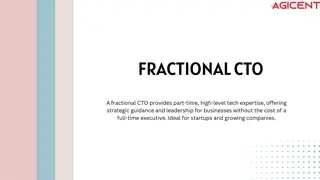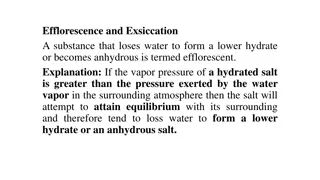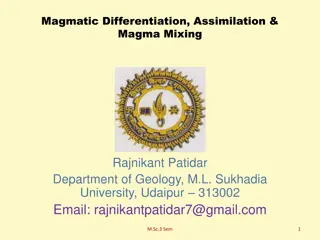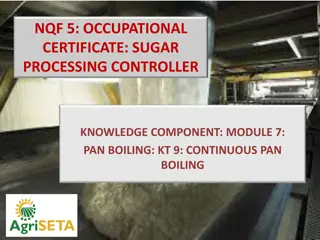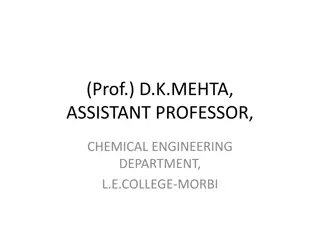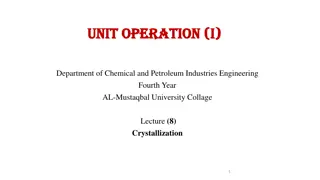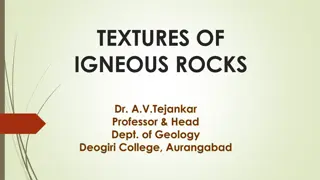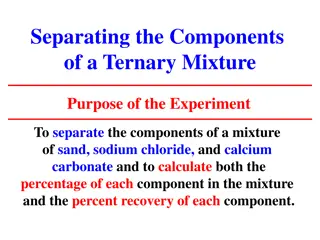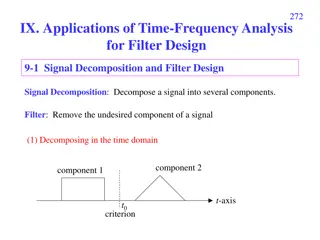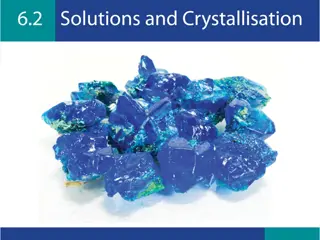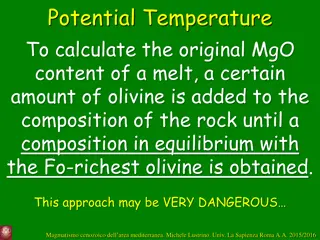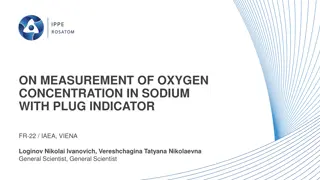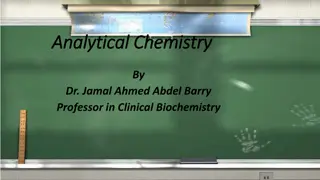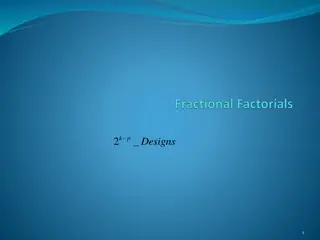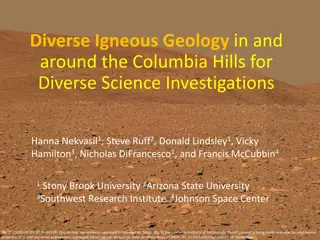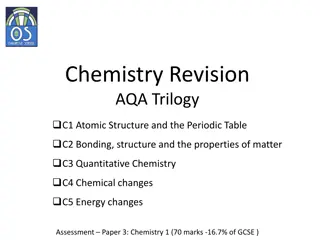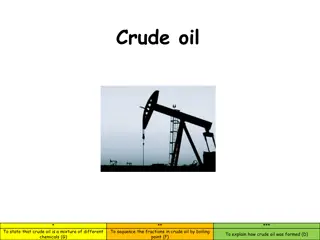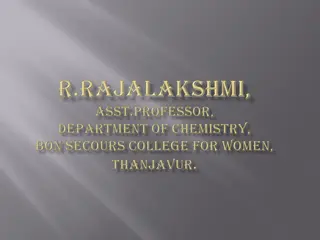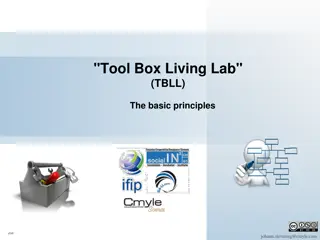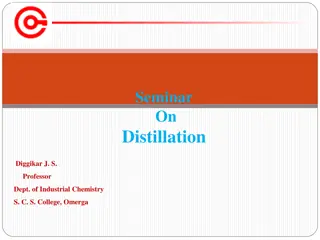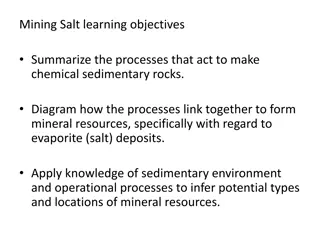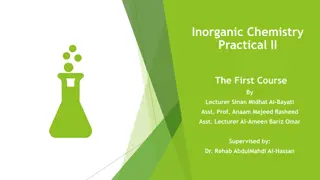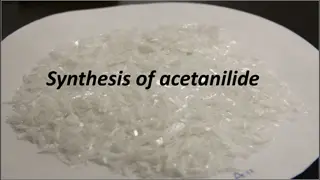Titration Colour Changes
This collection features various experiments in chemistry involving titration and solutions. It includes procedures such as standardizing hydrochloric acid using sodium carbonate, titrating hydrochloric acid with sodium hydroxide to produce sodium chloride, determining the concentration of ethanoic
0 views • 10 slides
Understanding Vernier Scales and Precision Measurement Devices
Vernier scales, named after French cartographer Pierre Vernier, enhance precision in measuring even the smallest scale divisions. Instruments like the theodolite, slide calipers, and Fortin's barometer utilize vernier scales for accurate readings. Learn about key terms like least count and vernier c
5 views • 11 slides
Understanding the Basic Principles of Distillation
Distillation is a process used to separate components in a liquid mixture based on differences in vapor pressures. This involves techniques like simple, steam, and fractional distillation, as well as understanding binary mixtures, boiling points, vapor pressures, and vapor-liquid equilibria. Raoult'
5 views • 42 slides
Understanding Syrups: Types, Formulations, and Storage Considerations
Syrups are sweet, viscous liquids used in pharmaceutical preparations. They can be non-medicated for flavoring or medicated for therapeutic purposes. There are sugar-based and sugar-free syrups, with sucrose preferred for its purity and handling ease. Preservatives like benzoate and sorbic acid are
4 views • 16 slides
Fractional CTO for Startups: Key Responsibilities
A Fractional CTO provides part-time, high-level tech expertise, guiding your business in strategy, development, and growth without the cost of a full-time executive.\n\nVisit:- \/\/ \/fractional-cto\n
0 views • 6 slides
Real World Asset Tokenization in Blockchain Technology
Tokenization of real-world assets in blockchain technology digitizes physical assets into blockchain tokens, increasing liquidity, transparency, and accessibility by transforming traditional markets through fractional ownership and automated smart contracts.
0 views • 9 slides
Efflorescence and Exsiccation in Chemistry
Efflorescence refers to the process where a substance loses water to form a lower hydrate or becomes anhydrous due to differences in vapor pressures. Hydrates with vapor pressures greater than the atmosphere tend to exhibit efflorescence. The rate of efflorescence increases with temperature. Exsicca
0 views • 103 slides
Understanding Mixtures and Separation Techniques
Explore the concepts of mixtures and separation, from the definition of dominant and recessive alleles to the advantages of electron microscopes. Learn about identifying pure substances, differences between pure and impure substances, and techniques like filtration and crystallization for separation
1 views • 19 slides
Understanding Magmatic Differentiation and Magma Mixing
Magmatic differentiation is the process through which a single homogeneous magma can produce diverse rock types by generating fractions of different compositions. This variation in igneous rocks results from mechanisms like fractional crystallization, liquid immiscibility, vapor transport, and diffu
1 views • 29 slides
Understanding Continuous Pan Boiling in Sugar Processing
Continuous pan boiling is a key process in sugar production, involving multiple compartments where massecuite is heated and circulated. This method ensures efficient crystallization and control of brix levels for optimal sugar quality. The design, operation, and control of continuous pans play a vit
0 views • 11 slides
Understanding Crystallization Process: Key Steps and Factors
Crystallization is a process where material deposits from a supersaturated solution, forming microcrystals that grow into larger crystals. Nucleation and growth are essential steps, with supersaturation driving crystal formation. Factors like temperature and seeding influence the process, leading to
1 views • 21 slides
Crystallization Principles in Chemical Engineering: Understanding Crystal Formation and Purification Methods
Crystallization is a key process in chemical engineering, involving the formation of solid particles within a homogeneous phase to obtain pure chemical substances. This article discusses the principles of crystallization, the importance of crystal size control, equilibria in the process, and the con
1 views • 40 slides
Crystallization Process in Chemical and Petroleum Industries
Crystallization is a purification method used in industries to produce crystalline materials like sugar and citric acid. It involves nucleation and crystal growth stages. Key terms include nucleation, solubility, and supersaturation, impacting crystal formation. Various methods like cooling, evapora
1 views • 19 slides
Understanding Fractional Reserve Banking Through Multiple-Choice Questions
Test your knowledge of fractional reserve banking with a series of questions covering topics such as its history, profit mechanisms for banks, the money supply, reserve requirements, excess reserves, and the impact of reserve ratio changes on the money supply. Explore concepts related to commercial
1 views • 12 slides
Understanding Textures of Igneous Rocks in Geology
Structures associated with igneous rocks are primary features that contribute to their strength, distinguish rock groups, and reveal origin. Textures, like crystalline patterns, indicate cooling and crystallization processes. Different cooling rates lead to varied textures such as holocrystalline, h
0 views • 16 slides
Separating Components of Ternary Mixtures: Experiment and Methods
Experiment aims to separate sand, sodium chloride, and calcium carbonate in a mixture to calculate percentages and recovery. Explore various methods like chromatography, distillation, extraction, centrifugation, crystallization, and sublimation for component separation.
1 views • 30 slides
Separation and Purification of Organic Compounds: Methods and Techniques
The separation and purification of organic compounds are essential processes to obtain pure products, as impurities and side reactions can affect the quality of the compounds. Methods such as solution and filtration, crystallization, distillation, extraction, sublimation, and chromatography are comm
8 views • 15 slides
Experimenting with Supersaturated Solutions: Rock Candy Creation
Exploring the phenomenon of supersaturated solutions through an experiment creating rock candy. The solubility of sucrose in water is observed at different temperatures, showcasing how more sugar can dissolve in a hot solution than in a cold one. The process of supersaturation and crystallization is
0 views • 11 slides
Exploring Tupelo Honey Varieties_ Which One Is Right for You_
Tupelo honey, often misspelled as \u2018Tupalo honey\u2019, is a rare and prized variety that\ncaptivates honey enthusiasts worldwide. Known for its distinctive flavor, smooth\ntexture, and resistance to crystallization, this golden elixir offers a u
0 views • 5 slides
Applications of Time-Frequency Analysis for Filter Design
Signal decomposition and filter design techniques are explored using time-frequency analysis. Signals can be decomposed in both time and frequency domains to extract desired components or remove noise. Various transform methods like the Fourier transform and fractional Fourier transform are employed
1 views • 35 slides
Supercooling Different Types of Water Experiment
This experiment explores the process of supercooling different types of water to understand which type can maintain a liquid state below zero degrees Celsius. The procedure involves cooling the water below its freezing point without it solidifying, aided by adding ice and monitoring temperatures. Th
1 views • 18 slides
Understanding Solutions and Solubility in Chemistry
Explore the concepts of solutions, solvents, solutes, and solubility in chemistry through investigations with various substances and solvents. Learn how to differentiate between dilute, concentrated, and saturated solutions, measure solubility, create solubility curves, and understand crystallizatio
0 views • 36 slides
Understanding Olivine Equilibrium in Calculating Original Magma Composition
The process involves analyzing olivine in basaltic rocks, selecting olivine with the highest Fo content, calculating the melt composition in equilibrium with this olivine using the distribution coefficient (KD), and determining the potential temperature (Tp) based on the MgO content. The distributio
0 views • 30 slides
Petrology and Geochemistry Study of Ongonites from Ary-Bulak Massive
Investigating the composition and crystallization of ongonites, this study conducted experiments on rocks from Ary-Bulak at varying conditions. The geological structure, facies zonation, and age of the ongonites were analyzed. Ongonites were found to be a subvolcanic analogue of rare metal LiF grani
0 views • 30 slides
Measurement of Oxygen Concentration in Sodium with Plug Indicator FR-22
Determining oxygen concentration in sodium using plug indicators is crucial for experimental facilities and nuclear reactors. This involves lowering sodium temperature slowly until sodium oxide crystallization begins, indicating saturation temperature (TS). Several solubility equations exist for cal
0 views • 6 slides
Optical Security with Double Random Fractional Fourier Domain Encoding
Utilizing double random fractional Fourier domain encoding for optical security involves encryption and decryption methods based on the fractional Fourier transform of various orders, involving specific mathematical operations and notations. The process includes transforming the input function, encr
0 views • 13 slides
Understanding Analytical Chemistry: Solutions and Miscibility
Explore the fundamentals of solutions in analytical chemistry, including the types of solutions, role of solutes and solvents, and the concept of miscibility. Learn about the six types of solutions based on phases, the general rule of miscibility, and the solution process involving dissolution and c
0 views • 17 slides
Understanding Fractional Factorials in Experimental Designs
Explore the concept of fractional factorials in experimental designs, including the basics, factors, terms estimation, confounding, and practical considerations for running treatment combinations. Learn how to generate incomplete blocks, use orthogonal contrasts, identify confounded terms, and alloc
0 views • 24 slides
Exploring Diverse Igneous Geology in and around the Columbia Hills
Studying the diverse igneous geology in and around the Columbia Hills provides insights into Martian atmosphere, volatile budget, age, source characteristics, cooling history, and more. Researchers have uncovered valuable information by coupling unaltered igneous rocks with meteorites and surface sp
0 views • 19 slides
Chemistry Revision: Atomic Structure and the Periodic Table - AQA Trilogy
Explore key concepts in Chemistry Revision for AQA Trilogy including atomic structure, periodic table organization, separation techniques, symbol equations, electron structures, isotopes, and more. Learn about burning magnesium, crystallization, chromatography, fractional distillation, and propertie
0 views • 10 slides
Understanding Crude Oil and Fractional Distillation Process
Crude oil is a mixture of various chemicals formed from the decomposition of microscopic plants and animals. Through fractional distillation, the fractions in crude oil are separated based on boiling points to obtain products like petrol, diesel, and lubricating oil. The process involves heating the
0 views • 15 slides
Techniques for Separating Mixtures: A GCSE Guide
Explore various separating techniques such as chromatography, distillation, filtration, and crystallization for different mixtures in a GCSE science context. Learn how to separate substances like solutes, solvents, liquids with similar boiling points, magnesium, salt, and more. Engage in a challengi
0 views • 5 slides
Understanding Special Topics in Design: Factorial Experiments and Fractional Designs
This content delves into the world of factorial designs used in design experiments to identify important factors and interactions. It explores 2k full factorial designs and their application in screening potential factors. Additionally, the content discusses 2k-p fractional factorial designs and the
0 views • 19 slides
Understanding Anthracene: A Polycyclic Aromatic Hydrocarbon
Anthracene, a polycyclic aromatic hydrocarbon, is composed of three fused benzene rings and exhibits unique properties such as a blue fluorescence when crystallized with benzene. It is commonly found in coal tar and has various industrial applications, including dye production, smoke screens, wood p
0 views • 25 slides
Exploring Tool.Box.Living.Lab: A Collaborative Innovation Platform
The Tool Box Living Lab (TBLL) is an open innovation research method that fosters collaboration among diverse profiles to generate ideas and solutions. It focuses on co-creation with end users and stakeholders in a real-life setting, promoting the emergence of common views, innovations, and collabor
0 views • 15 slides
Understanding Distillation: A Comprehensive Overview
Distillation is a crucial separation technique used in chemistry to purify materials by separating liquids with different boiling points. This process involves simple and fractional distillation methods, each with specific steps and applications. The article discusses the importance, advantages, and
0 views • 13 slides
Formation of Salt Deposits: Processes and Mineral Resources
Understanding the processes involved in the formation of chemical sedimentary rocks, particularly evaporite deposits like salt, is crucial for inferring potential mineral resources. This involves concepts such as evaporation, chemical weathering, crystallization, and lithification, which link togeth
0 views • 4 slides
Preparation of Calcium Peroxide (CaO2) in Inorganic Chemistry Practical II
This practical experiment details the preparation of calcium peroxide, a solid peroxide used in various industries and agriculture. The procedure involves the reaction of calcium salt and sodium peroxide to synthesize calcium peroxide, which has applications in agriculture, aquaculture, ecological r
0 views • 7 slides
Synthesis and Purification of Acetaminophen (Paracetamol) for Analgesic Properties
Acetaminophen, a widely used analgesic and anti-pyretic agent, is synthesized and purified in this experiment. The process involves suspending P-aminophenol in water, reacting with acetic anhydride, filtering, crystallizing, and collecting the product. The compound's mechanism of action, chemical pr
0 views • 15 slides
Acetanilide Synthesis Procedure: Step-by-Step Guide
Acetanilide is synthesized from aniline through a detailed procedure involving the acetylation process with acetic anhydride, concentrated HCl, and sodium acetate. The experiment requires careful mixing, addition of solvents, filtration, crystallization, and yield calculation. This comprehensive gui
0 views • 8 slides


